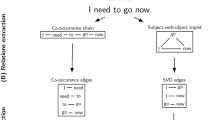Abstract
Japan’s suicide death rate is one of the highest in the world, especially among young people. According to a 2022 survey, about half of young people have had feelings of wanting to die in the past. In order to solve this problem, it is necessary to listen to the actual voices of those who have suicidal thoughts and understand their backgrounds and factors. The purpose of this study is to capture the events that contribute to Japanese people having suicidal thoughts from the actual text data submitted. In addition, by creating time-series data, we will visualize how the factors that cause people to have suicidal thoughts are changing. Using the data of questions posted on Yahoo! Chiebukuro, we extracted questions containing “Shinitai” (English: wanting to die) and conducted co-occurrence network analysis by nouns. From the co-occurrence network analysis, we were able to divide the nouns that frequently occur in the actual statements of people who have suicidal thoughts into six groups. Next, for each of the extracted nouns, we obtained the TF value (Term Frequency) over a period of time and observed its change over time in order to measure how much the word accounted for the sentences posted over a given period of time. There was a strong change in values from month to month, and no significant increase or decrease in the yearly transition was observed. Observations by time period showed that some words had higher TF values at certain times of the day.
Access this chapter
Tax calculation will be finalised at checkout
Purchases are for personal use only
Similar content being viewed by others
Disclosure of Interests
The authors have no relevant financial or non-financial interests to disclose.
References
LNCS Homepage. https://www.mhlw.go.jp/stf/seisakunitsuite/bunya/hukushi_kaigo/seikatsuhogo/jisatsu/sesakugaiyou.html. Accessed 3 Feb 2024
LNCS Homepage. https://www.nippon.com/ja/japan-data/h01624/. Accessed 15 Feb 2024
Kamizawa, T., Nakata, R., et al.: Research on relation of self-harm and psychological distress of young people (2016)
LNCS Homepage. https://www.nippon-foundation.or.jp/who/news/pr/2023/20230406-87204.html. Accessed 2 Feb 2024
LNCS Homepage. https://www.mhlw.go.jp/content/000527996.pdf. Accessed 3 Feb 2024
Eto, N., Kawasaki, H.: Actual situation of adolescent suicide and consideration of suicide prevention for them. Kyushu Neuro-Psychiatry 63(2), 75–82 (2017)
LNCS Homepage. https://chiebukuro.yahoo.co.jp/. Accessed 3 Feb 2024
LY Corporation (2020, 2023): Yahoo! Chiebukuro Data, 3rd edn. Informatics Research Data Repository, National Institute of Informatics. https://doi.org/10.32130/idr.1.3
LNCS Homepage. https://about.yahoo.co.jp/info/blog/20171129/chiebukuro.html. Accessed 2 Feb 2024
Sato, H., Yoshida, F.: Self-disclosure on the Internet: the effects of anonymity of the self and the other. Jpn. Psychol. Res. 78(6), 559–566 (2008)
Ferriter, M.: Computer aided interviewing and the psychiatric social history. Soc. Work. Soc. Sci. Rev. 4(3), 255–263 (1993)
Kariya, A., Okada, H., et al.: Internet-based inquiries from users with the intention to overdose with over-the-counter drugs: qualitative analysis of Yahoo! Chiebukuro. JMIR Form. Res. 7(e45021), JMIR Publications Inc. (2023)
Kawashima, A.: Marital conflict resolutions expressed in “Yahoo! Answers.” Bull. Faculty Educ. Chiba Univ. 61, 185–191 (2013)
Sakai, Y., Ito, E.: Extracting buzzwords from the Yahoo! Chiebukuro dataset. In: 2019 Kyushu Section Joint Convention of Electrical and Information Related Societies (2019)
LNCS Homepage. https://www.nii.ac.jp/dsc/idr/userforum/poster/IDR-UF2022_P01.pdf. Accessed 1 Feb 2024
Mori, S., Nagao, M.: An improvement of a morphological analysis by a morpheme clustering. Nat. Lang. Process. 5(2), 75–103 (1998)
Ida, A., Kitamura, Y., et al.: Discovered rule filtering method using MEDLINE information retrieval. Technical report, 102(710), 5–10 (2003)
Higuchi, K.: A two-step approach to quantitative content analysis: KH coder tutorial using Anne of green gables (Part I). Ritsumeikan Soc. Sci. Rev. 52(3), 77–91 (2016)
LNCS Homepage. https://www.mext.go.jp/content/20200824-mext_jidou01-000009294_011.pdf. Accessed 1 Feb 2024
Acknowledgments
In this paper, we used “Yahoo! Chiebukuro data (3rd edition)” provided by LY Corporation via IDR Dataset Service of National Institute of Informatics.
Author information
Authors and Affiliations
Corresponding author
Editor information
Editors and Affiliations
Rights and permissions
Copyright information
© 2024 The Author(s), under exclusive license to Springer Nature Switzerland AG
About this paper
Cite this paper
Takashima, K., Asahi, Y. (2024). A Study of Factors Having Suicidal Thoughts in the Japanese. In: Mori, H., Asahi, Y. (eds) Human Interface and the Management of Information. HCII 2024. Lecture Notes in Computer Science, vol 14690. Springer, Cham. https://doi.org/10.1007/978-3-031-60114-9_19
Download citation
DOI: https://doi.org/10.1007/978-3-031-60114-9_19
Published:
Publisher Name: Springer, Cham
Print ISBN: 978-3-031-60113-2
Online ISBN: 978-3-031-60114-9
eBook Packages: Computer ScienceComputer Science (R0)




